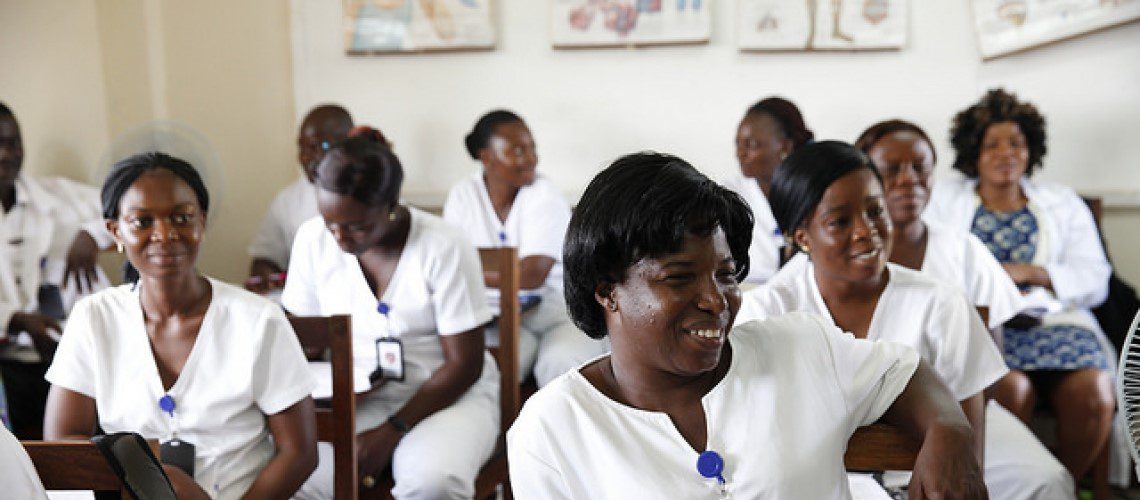This blog was written by World Bank specialists: Margo Hoftijzer, Senior Economist in Education Global Practice; Victoria Levin, Economist in Education Global Practice and a co-Lead of the Skills Global Solutions Group; Indhira Santos, Senior Economist, Social Protection and Labor Global Practice, World Bank; and Michael Weber, Senior Economist – Jobs Diagnostics (Supply), Labor Regulations & Social Insurance. The blog was originally published on the World Bank Education for Global Development website on 4 May 2020.

Nurses listen during a training program to learn more about child and adolescent mental health in Monrovia, Liberia
Technical and Vocational Education and Training (TVET) programs are well-placed to play an important role in the COVID-19 pandemic. They have significant potential to contribute in three stages: the current “coping” phase, an intermediate phase when schools and businesses gradually reopen, and during the recovery period when structural changes are expected in both the education system and in the labor market.
Right now, however, more than 1.2 billion students worldwide are affected by school closures amid COVID-19, including in the TVET system. Learning is often being done remotely, through the internet, television or radio, for example. However, the degree to which learning can still take place outside the classroom, including in TVET, is often limited by lack of access to electricity, internet connectivity, devices or media, learning platforms, or the inadequate preparation of instructors and students for remote education. Some students, particularly women and girls, face additional constraints in terms of time availability due to competing responsibilities, such as caring for children and elderly family members and other household duties. Adjustments to distance learning can be the hardest in low-income contexts and among vulnerable students.
The hallmark of TVET – its focus on practical skills and work-readiness – makes remote learning particularly challenging. Practical skills are often acquired through learning-by-doing, which occurs in school-based workshops and laboratories or through hands-on experience at the workplace. Remote learning approaches are a weak substitute for practical exercises when they require the use of equipment or materials not usually found inside the home. In some contexts and for some occupations, practical training can be simulated remotely via, for example, virtual or augmented reality experiences. In general, however, TVET programs that struggle most with adjustment to distance learning are those that depend heavily on learning-by-doing. In contrast, programs that can switch to remote learning more easily are those with a stronger emphasis on academic subjects or on work-specific skills that do not require manual activities. For example, a program on cyber-security will be relatively easy to move online compared to a program on automobile mechanics as the latter requires substantial hands-on practice.
A silver lining for some TVET students and programs is that work-based learning can continue in cases where businesses remain open. In some contexts, precautionary measures can be taken to allow students to complete their practical training. For some occupations and in contexts with adequate connectivity, work-based learning can also go on uninterrupted through virtual internships or apprenticeships. That said, where there is widespread or prolonged closures of businesses or extensive physical distancing limits as businesses reopen, graduation or certification requirements associated with work-based learning may need to be modified or postponed.
TVET’s targeted, short-term and potentially modular approaches can help countries in coping with the crisis. In the immediate term, when countries are focused on coping with COVID-19, the training system can help address needs for health care workers, those engaged in producing relevant medical equipment (such as personal protective equipment and ventilators), or those who provide essential childcare and eldercare services. Previous pandemics provide insights about the potential held by TVET programs during crises. During the 2014/15 Ebola outbreak in Sierra Leone, a National Ebola Training Academy was set up to offer a platform of clinical training modules for frontline Ebola health care workers. The intensive short-term training provided through the Academy was found to have contributed to controlling the outbreak. It may also be possible to effectively engage current TVET students in the COVID-19 response.
In the intermediate phase, as activities restart and schools gradually reopen, TVET can play a role in supporting the transition to most likely a “new normal.” Lifting of lockdowns on schools and businesses will call for greater attention to health and safety measures and increased need to prepare for disruption in case of new COVID-19 flareups. TVET can support the training of needed professionals, continuing in the health sector but also in occupations such as child care professionals, who can enable caretakers going back to work and adolescents back to school. At the same time, TVET systems can provide much-needed socioemotional skills support to teachers and students to manage the mental health impacts resulting from the crisis.
In the COVID-19 recovery phase, there are opportunities for smart investment in pre-service TVET and adult training to “build back better” programs and systems. In this phase, TVET can cater to students who dropped out during school closures and reskilling or upskilling those who have become unemployed. TVET can also facilitate the development of skills necessary for the adjustment to structural changes brought on by the COVID-19 pandemic. Continued focus on ensuring acquisition and development of foundational cognitive and socioemotional skills, such as empathy and resilience, which have become increasingly valued in the current circumstances, will improve employability and other human development outcomes for TVET students. Moreover, investment in learning technology and digital skills of TVET instructors and students can ensure lifelong access to learning opportunities and future workforce adaptability.
So, how are TVET programs and students doing during the COVID-19 crisis? How are countries planning to adapt TVET to what comes next? The World Bank has joined forces with ILO and UNESCO to collect this information from TVET providers, policymakers, and social partners. You can help us to obtain a comprehensive picture of what TVET programs are doing to carry on their essential tasks and help mitigate the impacts of COVID-19 by participating in this survey (EN /FR /SP /RU /AR /CH/ VN/PT), which closes on May 15, 2020. We will report back on the results and give examples of different approaches countries are following. Stay tuned!




